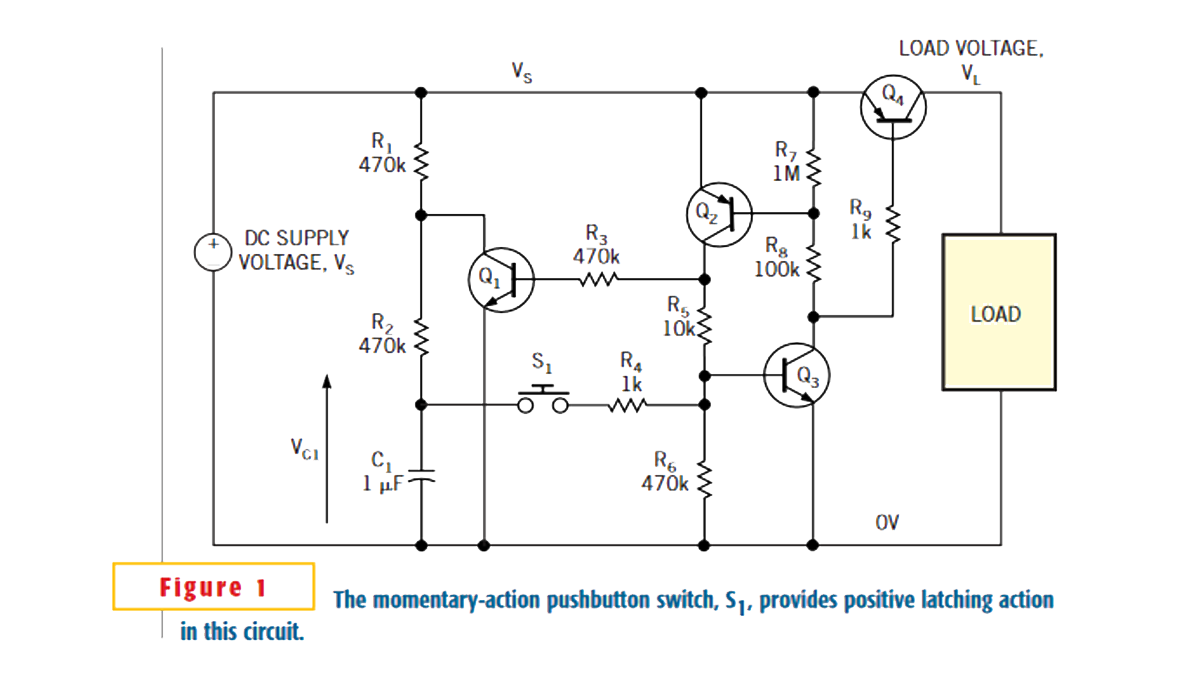Most inexpensive pushbutton switches, particularly pc-board-mounting and membrane types, have momentary action. Latching types are often larger and relatively expensive, and they frequently are unavailable in the style you’d like to use. You can thus have a problem if you need a small, inexpensive on/off switch for latching power to a load. The circuit in Figure 1 shows how you can use a simple, momentary-action, SPNO (single-pole, normally open) pushbutton switch to latch power to a load. Requiring just a handful of common, garden-variety components, the circuit works over a wide voltage range and is ideal for single-cell applications, because it can operate at voltages as low as 1V or less. Transistors Q2 and Q3 form an SCR-like structure that functions as a simple latch, Q4 switches power to the load, and S1 is the momentary pushbutton switch.

When you first apply the supply voltage, VS, all four transistors are off, and capacitor C1 charges via R1 and R2 until its voltage, VC1, is equal to VS. The circuit is now in its off, or unlatched, state, and the load voltage, VL, is 0V. A momentary closure of the pushbutton switch, however, causes C1 to dump its charge into the base of Q3, which conducts and furnishes bias for Q2 and Q4, which both turn on. Q2 now provides base bias for Q3 via R5, and also for Q1 via R3. The circuit is now in its on, or latched, state and remains that way even though S1 is open. The load is now energized, and VL is roughly equal to VS. Transistor Q1 is now saturated, causing C1 to discharge via R2 such that VC1 falls to a few tens of millivolts (Q1‘s collector-emitter saturation voltage). Another momentary closure of the pushbutton switch couples this low voltage to Q3‘s base, turning it off. As a result, all four transistors turn off, and the circuit reverts to its off, or unlatched, state. The load is now de-energized, and VL falls to 0V. Because Q1 is now off, C1 begins to charge again via R1 and R2, such that another momentary closure of S1 latches the circuit on again.
Timing capacitor C1, acting with R1 and R2, provides debouncing for the pushbutton switch, such that contact bounce has no effect on the desired latching function. Without the RC time delay, the circuit would “chatter” on and off each time you pressed the pushbutton switch and would end up in an indeterminate state. Although Figure 1 shows a value of 1 µF, other values may be more suitable for a particular application, so prepare to experiment. None of the resistor values is particularly critical, and the values shown in Figure 1 are fairly optimal for a supply voltage of approximately 1 to 1.5V—in other words, a single cell. At higher voltages, the resistor values should increase proportionally, although you should hold R2 and R4 constant at approximately 470 and 1 kΩ, respectively. Keeping the R2-C1 time constant fixed at a few hundred milliseconds ensures that the time taken to discharge the capacitor is not excessive; otherwise, once the circuit has been latched, there may follow an unacceptable delay before it can be unlatched. Resistor R4 limits the current flowing from C1 into Q3‘s base to a safe level; its value should be fairly small to ensure that R5 and R6 do not distort the voltage appearing at Q3‘s base when the switch closes.
Read more: Latching power switch uses momentary-action pushbutton
